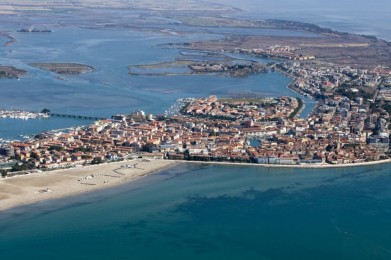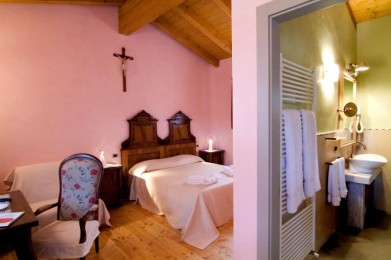The origins of the Basilica of St. Eufemia are very ancient. In fact, by the 4th century the “little basilica of Petrus” already existed, on which Niceta laid the foundations for a new church in the early 5th century. However, the new building was finished in 579 by Bishop Elias, who by then resided permanently in Grado. Elias dedicated the basilica to the Aquileian protomartyrs Hermacoras, Fortunatus and Euphemia (martyr of Chalcedon), so as to reaffirm the full fidelity of the Church of Aquileia to the anti-Arian resolutions of the Council of Chalcedon. Also nearby is the 15th-century bell tower turnpike characterized by the Anzolo San Michele, which is the symbol of Grado, the Baptistery, the Lapidarium, and the Basilica of Santa Maria della Grazie, the oldest in the entire village.
The interior of the basilica is structured in three naves on columns with capitals that govern the arches. In the apsidal basin you will find a large fresco depicting Christ in a mandorla, surrounded by the symbols of the Evangelists, the Madonna, Santa Ermacora, from San Giovanni Battista and San Fortunato. Above the altar will not be difficult to identify the blade of gilded silver, masterpiece of goldsmith veneziana, Donato Mazzalorsa. You’ll be captivated by the pulpit of the XI century, supported by six columns with leafy capitals covered by reliefs depicting the symbols of the evangelists and a cross. The pulpit is also covered by a dome of Foggia moresca On trefoil arches curved inwards (very probably an addition of the gothic era).
In the left nave you can appreciate the “trichora”, cell from a form similar to the chapel of San Marco, while in the right aisle the mausoleum that preserves original parts such as brick vaults and the mosaic in which stands out the monogram of Elijah (HELIAS EPISCOPUS). The wall is walled safe guarding the treasure of the Duomo. Thanks to the recoveries made during the years you can also take thou also unto the journey of catecumene through the floor mosaics, where you will also find a mosaic representing the “Castrum of degree”.
The floor of the Cathedral is very similar to the stylistic canons Byzantines (schematic geometric and), the reason most illustrious is that of the underwater wave. The Mosaics have also a significant value, proven , by approximately 40 inscriptions commemorating , the name of those who contributed to the expenditure for the realization.
Opening hours:
Winter: from monday to sunday 8-18.
Summer: from monday to sunday 8-19.
Free entrance



